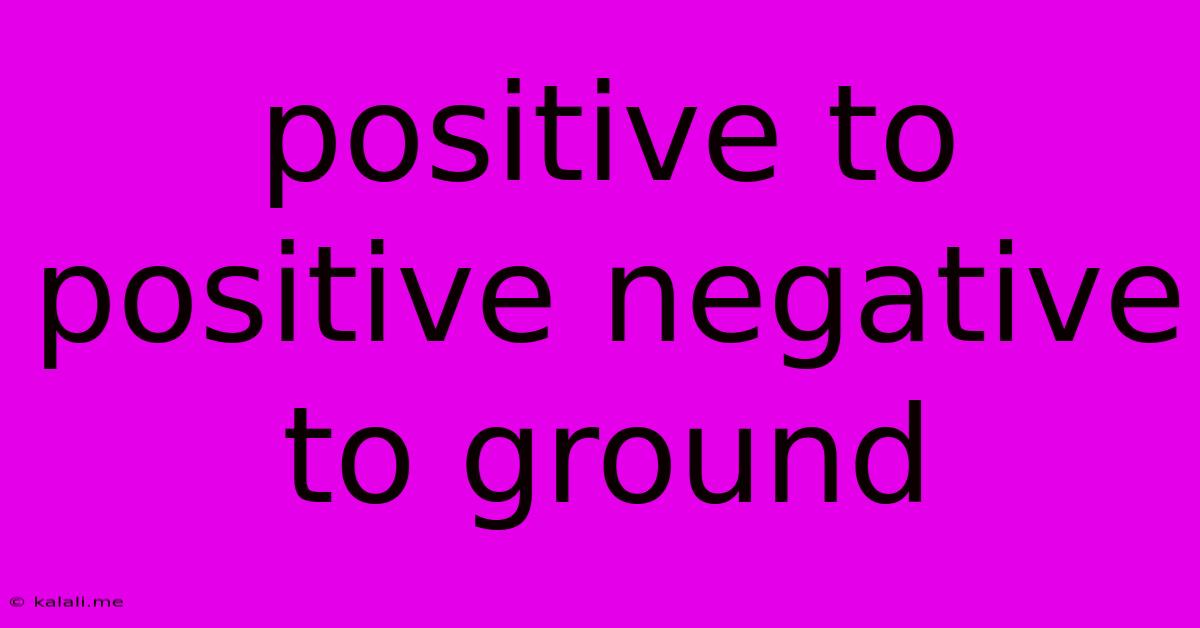Positive To Positive Negative To Ground
Kalali
Jun 09, 2025 · 3 min read

Table of Contents
Positive to Positive, Negative to Ground: Understanding Voltage and Current Flow
This article will explain the fundamental concept of "positive to positive, negative to ground" in electrical circuits, a crucial understanding for anyone working with electronics, whether it's a simple project or a complex system. We'll delve into the basics of voltage, current, and grounding, clarifying common misconceptions. This explanation is perfect for beginners, providing a solid foundation for more advanced learning.
What is Voltage?
Voltage, also known as electromotive force (EMF), is the potential difference between two points in an electrical circuit. It's the "push" that drives electrons through a conductor. Think of it like water pressure in a pipe; the higher the pressure, the stronger the flow. A higher voltage means a greater potential for current to flow. We often measure voltage in volts (V).
What is Current?
Current is the flow of electric charge through a conductor. It's the actual movement of electrons propelled by the voltage. Using our water analogy, current is the amount of water flowing through the pipe. We measure current in amperes (amps or A).
What is Ground?
Ground, or earth ground, is a reference point in an electrical circuit. It's typically connected to the earth itself, providing a path for excess current to safely dissipate. Imagine it as a large reservoir for excess water in our pipe analogy. Grounding ensures safety by preventing dangerous voltage buildup and providing a return path for current.
Positive to Positive, Negative to Ground: Explained
The phrase "positive to positive, negative to ground" describes a specific circuit configuration. It's crucial to understand that this isn't universally applicable to every circuit. However, it's commonly used in situations where a voltage source (like a battery) is connected to a load (like a lightbulb).
- Positive to Positive: This indicates that the positive terminal of the voltage source is connected to the positive side of the load. This provides the driving force for the current.
- Negative to Ground: This signifies that the negative terminal of the voltage source is connected to the ground. This completes the circuit, providing a return path for the current to flow back to the voltage source.
Why is Grounding Important?
Grounding serves several vital purposes:
- Safety: It provides a path for fault currents to flow to the earth, preventing dangerous electric shocks.
- Noise Reduction: Grounding helps to minimize electrical noise and interference in the circuit.
- Stable Voltage Reference: Ground provides a stable reference point for measuring voltages within the circuit.
- Protection from Surges: Grounding offers protection against voltage surges and spikes that could damage sensitive components.
Common Misconceptions
- Ground is always zero volts: While ground is often considered zero volts, it's more accurate to say it's a reference point. Other voltages in the circuit are measured relative to ground.
- Ground is always connected to the earth: While this is often the case, especially in larger systems, ground can also be a designated point within a circuit.
In Conclusion
Understanding the concept of "positive to positive, negative to ground" is fundamental to grasping basic electrical principles. This configuration, although not universally applicable, serves as a good starting point for comprehending voltage, current, and the crucial role of grounding in ensuring a safe and functional electrical circuit. Remember to always prioritize safety when working with electricity and consult relevant safety guidelines. This basic understanding lays the groundwork for exploring more complex circuits and applications in the future.
Latest Posts
Latest Posts
-
How To Pick Up A Snail
Jun 09, 2025
-
What Gets Off Candle Wax In A Holder
Jun 09, 2025
-
Sin Is Crouching At The Door
Jun 09, 2025
-
How To Undo A Rounded Bolt
Jun 09, 2025
-
Wifi Does Not Have An Ip Address
Jun 09, 2025
Related Post
Thank you for visiting our website which covers about Positive To Positive Negative To Ground . We hope the information provided has been useful to you. Feel free to contact us if you have any questions or need further assistance. See you next time and don't miss to bookmark.